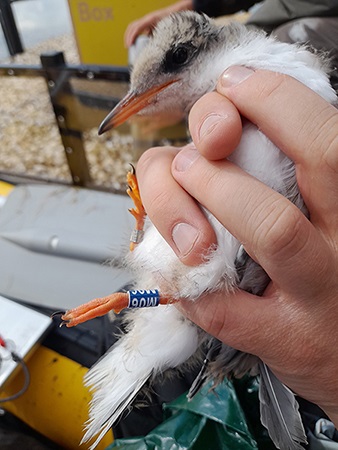
It’s a bird lover’s delight as Bothkenner Lagoons witnessed a remarkable population boom among the endangered Common Tern.
And it’s all thanks to a local environmental initiative which set out to increase nesting sites for the Common Tern by installing nesting rafts on the lagoon.
Falkirk Council worked with the Inner Forth Landscape Partnership and The Conservation Volunteers to install an initial two rafts in 2016 which were monitored by the Countryside Rangers with little success.
In 2021, in partnership with the RSPB and Falkirk Wildlife Conservation Group, Falkirk Council repaired and improved these rafts. The improved rafts were used by one breeding pair of terns in 2021.
Since then Falkirk Council has installed a further five rafts with the addition of predator control sheets along all four sides of the rafts.
Forty-five breeding pairs of terns nested on the rafts in the summer of 2023.
Councillor Bryan Deakin, spokesperson for Climate Change said: “Protecting and conserving our wildlife has never been more important in times where we are seeing a loss of biodiversity. The success at Bothkenner is testament to the perseverance and patience of staff and conservation groups who over a number of years have adapted the initial project to make it the success it is now”
Bothkennar lagoons are located within a Site of Special Scientific Interest, designated for important habitat, flora or fauna, and forms part of the Firth of Forth Special Protected Area, designated specifically to protect rare or vulnerable birds. The Common Tern is on the UK Amber list for birds of conservation concern.
Green Future Building supplied the rafts and built them on site. The main body of the raft is made from recycled plastic and the cockle shells, on which the Terns nest, were a by-product from the cockle industry. Since the rafts are primarily made of re-cycled plastic they require very little maintenance.
Lesley Sweeney, Falkirk Council’s Countryside Ranger said: “In partnership with Clyde ringing group the breeding site was visited in July to colour and metal ring as many chicks as possible. Forty nine chicks were ringed with many others being too young to ring.
“Coloured rings help to record the movement of migratory waders more easily as they can be monitored and recorded by using binoculars. All colour ringing projects are approved by the British Trust for Ornithology (BTO) and follow BTO guidelines. Each ring number is unique to each individual bird.
“Once the breeding season was over we visited the rafts to check all the chicks had fledged. We will check on the rafts again before the birds come back next year.”

The Common Terns nest on the lagoons between May and August and then fly off to a warmer climate.
The five new tern rafts were funded by Falkirk Council using money that was provided by the Scottish Government specifically for nature restoration projects.